Newton Abbot
| Newton Abbot | |
| Devon | |
|---|---|
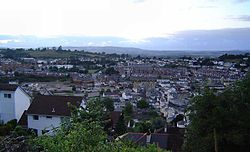 Newton Abbot from Wolborough Hill | |
| Location | |
| Grid reference: | SX860713 |
| Location: | 50°32’25"N, 3°36’31"W |
| Data | |
| Population: | 23,580 (2001) |
| Post town: | Newton Abbot |
| Postcode: | TQ12 |
| Dialling code: | 01626 |
| Local Government | |
| Council: | Teignbridge |
| Parliamentary constituency: |
Newton Abbot |
Newton Abbot is a market town in East Devon, on the banks of the River Teign, with a population of 23,580.[1]
Newton Abbot has a racecourse nearby situated in the parishes of Kingsteignton and Teigngrace and boasts one country park, Decoy. Part of Newton Abbot's heritage is the Cheese and Onion Fayre, originally held from the 5th to 7 November in honour of Saint Leonard, but now celebrated at the beginning of September.[2]
The town grew very rapidly in the Victorian period as it was home to the South Devon Railway locomotive works. This later became a major steam engine shed and was retained to service British Railways diesel locomotives, although it has now closed and is the site of an industrial estate.
History
Early history
Newton Abbot was created in the Middle Ages from the villages of Highweek and Wolborough.
The remains of a Norman motte-and-bailey castle survive on Highweek Hill; probably a lookout post to watch people coming up the Teign estuary. A village grew up around this castle which over the years became Highweek "the village on the high ground". On the low ground around the river Lemon arose another settlement which became part of Wolborough Manor.
The markets
Torre Abbey owned the lands on this part of the Teign and created a town. The New Town of the Abbots was given the right to hold a weekly market on Wednesdays sometime between 1247 and 1251. By 1300 the two settlements were renamed as Newton Abbot (on the low ground) and Newton Bushel (on the high ground). On the strength of the market it quickly became a successful thriving town and a good source of income for Torre Abbey.
Over the river on the Highweek side another weekly market was created. This one ran on Tuesdays and because the Bushel family were the landowners this community became known as Newton Bushel. Over the next 200 years Newton Bushel ran more annual fairs, a number of mills were set up and the leather and wool trades started. Newton Bushel was also a convenient place for travellers to stay.
Torre Abbey was dissolved in 1539 and ownership of Wolborough was granted to John Gaverock who built himself a new house at Forde. The twin markets of Newton Abbot and Newton Bushel continued until they were merged together in 1633 as a Wednesday weekly market under the ownership of Bradley Manor. By 1751 there was also a smaller Saturday market and three annual fairs, a cattle fair on June 24, a cheese and onion fair in September and a cloth fair on 6 November. The markets continued to expand so in 1826 a new market was built. Over the next 50 years the buildings became dilapidated so a substantial new market was built in 1871. The buildings included a pannier market, a corn exchange and a public hall—the Alexandra (now a cinema). The river Lemon was also covered over. Further enlargement took place in 1938 as a new cattle market and corn exchange were built. There has been a thriving market in Newton Abbot for over 750 years.
Wool and leather
In medieval times Devon was an important sheep rearing county. Many towns had their own wool and cloth industries and Newton Abbot had woollen mills, fullers, dyers, spinners, weavers and tailors. In particular, fellmongering (where wool is removed from the sheepskin) was well established in the town. In 1724 Daniel Defoe wrote that Newton Abbot had a thriving serge industry that sent goods to Holland by way of Exeter. The annual cloth fair was the town’s busiest fair. Over the 19th century Vicary’s mills became an important employer in the town and by the 1920s they employed over 400 men. However, by 1972 business had declined and the works finally closed down.
Associated with the woollen industry was the leather one. The hides left after the fellmongering process were made into leather. Tanners, shoe-makers, glovers and saddlers were all in business in Newton Abbot. As with the wool industry business flourished for over 600 years until after the Second World War.
The Newfoundland Trade
In 1583 Humphrey Gilbert, a local adventurer, landed at St John's, Newfoundland and claimed the area as a British colony. The fisheries quickly developed. Between 1600 and 1850 there was a steady trade between Newton Abbot and the cod fisheries off Newfoundland. Every year men from the town would gather at the Dartmouth Inn or Newfoundland Inn in East Street in the hope of being hired for a season’s work. In the autumn the dried cod was stored in depots and sometimes used as payment. There was considerable economic spin-off from this trade. Fish hooks, knives, waterproof boots and rope were all made in the town. The Rope Walk to be found in East Street just a few yards from the Cider Bar still exists, together with the names of Newfoundland Way and St John’s Street.
Ball clay and the Stover Canal
Just 2 miles northwest of Newton Abbot lie the large ball clay workings of the Bovey basin. The main workings are on the eastern outcrop of the deposits at Kingsteignton, which can lay claim to being the centre of Britain's ball clay industry. The Bovey Basin took millions of years to fill from rivers that flowed out of Dartmoor. The sediments included clay derived from the decomposed granite. The natural deposition has resulted in a clay that is purer and more refined than many others. Clay is used in a wide range of products such as bricks, tyres, porcelain, glossy magazines, medicines and toothpaste.
Kingsteignton clay was being used to make pipes around 1680. By 1700, it was being shipped from Teignmouth, and its use by the famous potter Josiah Wedgwood made it a success. The clay was extracted by simply digging out the lumps on courses—rather like peat cutting. The bulky clay was transported by packhorse to Hackney Quay at Kingsteignton where it was loaded on to barges for shipment down the Teign Estuary where it was transferred to small ships bound for Liverpool and other ports.
Towards the end of the 18th century, the ball clay industry was steadily expanding. A local landowner, James Templer, built the Stover Canal in 1792 to help ship clay along the canal and Teign Estuary from the Bovey Basin to the port of Teignmouth. Coal, manure and agricultural produce was also freighted along the canal. James Templer's father, also called James Templer, purchased the 80,000 acre Stover Estate near Newton Abbot in 1765. Granite from Hay Tor was used to build Stover House which was completed by 1792. By 1820 a granite tramway, which had rails cut from granite, was opened connecting the granite quarries of Haytor to the canal. This enabled large quantities of granite to be transported for major works like the new London Bridge which opened in 1825. George Templer, son of James Templer (the second) and brother of Rev John Templer, rector of Teigngrace, Devon, overspent his resources and was forced to sell Stover House, Stover Canal, the Haytor Granite Tramway and most of the rest of the family's considerable estates to Edward St Maur, 11th Duke of Somerset in 1829. The canal was extended to cope with this, and the industry fared well until 1858 when they were out-competed by the more economic Cornish coastal quarries. The Stover canal reverted back to shipping ball clay—which only really stopped by 1939.
The ball clay industry is now highly mechanised and very successful. The majority of the clay is now transported by road and transferred to ships at the nearby port of Teignmouth.
The Stover Canal Society was formed following a public meeting held in February 1999. The aims of the society are to preserve and restore the canal. Railtrack who owned most of the canal transferred ownership in 2005 for the sum of £1, to Teignbridge District Council for leisure use by the community. Work parties have made a start on clearing the canal to asses what further work is needed.
The railway
Newton Abbot railway station at the east end of Queen Street was opened with the coming of the South Devon railway in 1846. At once, Newton Abbot changed from being just a market town with associated trades to become a base for industry. A branch line to Torquay was added on 18 December 1848 and one to Moretonhampstead on 26 June 1866, although the latter has since closed to passengers. Isambard Kingdom Brunel used the Teignmouth / Newton Abbot section to experiment with his atmospheric railway, a failed experiment, but the remains of pumping house buildings still survive at Starcross and the old Dairy Crest milk processing factory in Totnes.
In 1876 the Great Western Railway bought the railways up and developed the repair and maintenance sheds into a substantial works that employed over 600 people to start with but by 1930 over 1,000 men were involved. Extensive sidings were also built making a large marshalling yard. The present station was rebuilt to its current form in 1926. The large clock was given by the people of the town.
Many other industries were set up beside the railway station—a timber yard, iron and brass foundries, engineering works. The town’s population increased from 1,623 in 1801 to 12,518 by 1901. Terraced streets were built to house the workers and attractively styled villas sprang up around the town for the wealthier professionals and retired people.
Recent history
The town was bombed twice in air raids during World War II, killing a total of 21. The town suffered a severe flood on 27 December 1979, the latest in a long series, when the River Lemon burst its banks after prolonged rain.
Landmarks
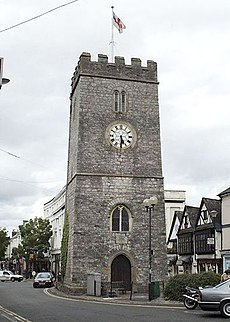
St Leonard's Tower
The centre of the town features the ancient tower of St Leonard. The tower is all that remains of the medieval chapel of St Leonard, founded in 1220 and first referred to in 1350 in a document of the Bishop de Grandisson of Exeter, the main chapel being demolished in 1836. Adjacent to the tower is a plaque marking the spot where the first declaration of the newly arrived William III, Prince of Orange was read in 1688. The plaque reads:
The first declaration of William, Prince of Orange, the glorious defender of the Protestant Religion and the liberties of England, was read on this pedestal by the Rev John Reynall, Rector of this parish, on November 5th 1688
William arrived in Brixham on the 5th November 1688 and reached Newton Abbot the next day, staying overnight in the town at Forde House as he made his way to London to assume the English throne.
Forde House
Forde House (now known as Old Forde House) is situated in the southeast corner of the town. The present house was built in 1610 by Richard Reynell and his wife Lucy. The house was built with an E-shaped floor plan, said by some to be in honour of the late Queen Elizabeth I, who had recently died. The grounds were originally quite extensive, and included the whole of what is called Decoy (so named, because wildfowl were decoyed there to extend the house's larder), as well as a deer park.
In 1625, King Charles I stayed at the house overnight on his way to inspect the fleet at Plymouth. He returned a few days later and stayed for a further two nights. Forde House later gave shelter to his enemies; Oliver Cromwell and Colonel Fairfax stayed while on their way to besiege Royalist Dartmouth in 1646. In 1648 the estate passed onto the Courtenay family via the marriage of Margaret (the only daughter of Jane Reynell and Sir William Waller) to Sir William Courtenay, who was the lord of nearby Powderham Castle. William of Orange stayed at Forde House on 6 November 1688 on the way to London to take the throne, having landed in Brixham the previous day.
The house remained the main residence of a succession of Courtenays until 1762 when the house was let to a succession of occupiers. The Courtenay family sold the house in 1936 to Mr Stephen Simpson, who sold it two years later to Mrs M Sellick. Teignbridge District Council bought the house in 1978 and remain the current owners. It has been refurbished by the Council and is now used as office and conference space as well as being used for weddings and other events.
Bradley Manor
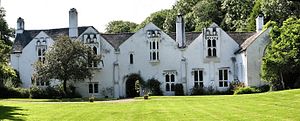
At the opposite end of Newton Abbot is the National Trust property, Bradley Manor, a 15th century manor house in its own secluded woodland setting, with a notable great hall emblazoned with the royal arms of Elizabeth I.
The Passmore Edwards Public Library
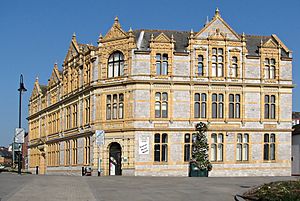
The Library was a gift to the town by John Passmore Edwards, in memory of his mother, who was born there. It opened in 1904 and is one of the most impressive in Newton Abbot. It originally housed both a library and a Science, Art and Technical School. The building was designed by the Cornish architect Silvanus Trevail.[3] The style is elaborate Renaissance, and much use is made of yellow terracotta mouldings over the windows and doorways. Passmore Edwards donated £2,500, while the County Council and a public subscription paid for the rest of the building. The library has currently moved to Teign House while its home is being refurbished.
Almshouses
- Gilberd’s almshouses in Exeter Road were endowed in 1538 by John Gilberd of Compton Castle to house lepers. There were five houses and they reputedly had sloping floors to help in washing the houses out. Eight modern apartments with a common room and visitors bedroom now occupy the site, which is administered by the Feoffees of Highweek.
- In 1576 Robert Hayman set a number of houses for poor people up in East Street. These were rebuilt in 1845 and can still be seen opposite the entrance to Newton Abbot hospital.
- Reynell’s almshouses were originally built in 1640 beside Torquay Road to house four clergy widows (‘the relicts of preaching ministers, left poor, without a house of their own’)
- Mackrell’s almshouses in Totnes Road were built in 1874. Mackrell was a native of Newton Abbot who made his fortune as a chemist in Barnstaple. Mackrell also funded a home in the Forde Park area for the "fallen women of Newton Abbot".
The Workhouse
The original Newton Abbot poorhouse was based in East Street, and the cellar of the Devon Arms was used as the oakum picking room, where paupers were assigned the unpleasant job of untwisting old rope to provide oakum, used to seal the seams of wooden boats. Newton Bushel had its own poorhouse, not far from present day Dyrons.
The Poor Law Amendment Act 1834 required changes though and incorporation, so in 1839, a new workhouse was built in East Street and was used to house paupers from the surrounding areas. Over time, the workhouse became more of a hospital for the sick, infirm, and aged poor. By 1890 there were nearly 400 inmates, and reports of cruel treatment. A new infirmary was built, and during the wars some of the buildings were used as a military hospital. By 1950, the workhouse buildings were incorporated into the present-day hospital.
Tucker's Maltings
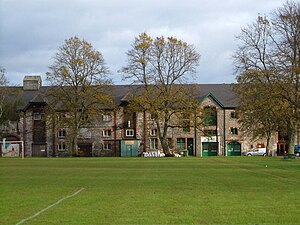
Close to the railway station is Tucker's Maltings, the only traditional malthouse in Britain open to the public. The malthouse offers the visitor hour-long guided tours, from the barley to beer discovery centre, and produces malt for over 30 breweries, and enough to brew 15 million pints of beer a year. In April every year, the maltings hosts a three-day beer festival, one of the finest in the country, where over 200 different real ales can be sampled.
Ye Olde Cider Bar
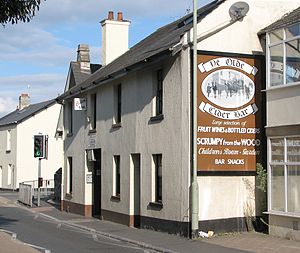
Said to be one of only two remaining cider houses in the United Kingdom,[4] Ye Olde Cider Bar in East Street sells only cider, perry, country wines and soft drinks. Its interior and the simple wooden furniture have remained relatively unchanged for over thirty years. However some of the old customs associated with the bar such as limiting women and holiday makers to half pint measures and covering the floor with sawdust have now gone.
Newton Abbot Town & G.W.R. Museum
A small museum adjacent to the Town Hall details the history of Newton Abbot and of the Great Western Railway. The museum also has a rail simulator which enables the users to drive a GWR steam train between Newton Abbot and Exeter St Davids.
References
- ↑ "Parish Headcounts". Neighbourhood Statistics. The Office for National Statistics. 2001-04-01. http://neighbourhood.statistics.gov.uk/dissemination/LeadTableView.do?a=3&b=793775&c=Newton+Abbot&d=16&e=15&g=437376&i=1001x1003x1004&m=0&enc=1&dsFamilyId=779. Retrieved 2008-12-20.
- ↑ Newton Abbot24 - Cheese and Onion Fayre
- ↑ Bridget Cherry & Nikolaus Pevsner (1989). The Buildings of England: Devon. Harmondsworth: Penguin. p. 591. ISBN 0140710507.
- ↑ Ye Olde Cider bar at Scrumpyandwestern
- Roger Jones (1986). A Book of Newton Abbot. Bradford on Avon, Wiltshire: Ex Libris Press. ISBN 0 948578 06 8.
- Derek Beavis (1985). Newton Abbot, The Story of the Town's Past. Buckingham: Barracuda Books. ISBN 0 86023 236 0.
- W. G. Hoskins (1954). A New Survey of England - Devon. London: Collins. pp. 441–443.
- Mary O'Hagan (1990). A History of Forde House. Frome, Somerset: Butler & Tanner Ltd.